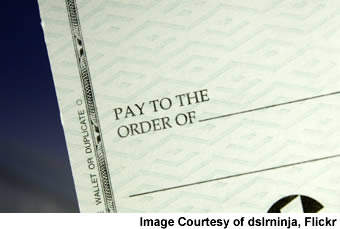Did you know that 40% of small businesses have a third of their receivables as 60-plus days delinquent? Did you also know that invoices may be part of the blame for this?
 By making sure your invoices are clear, correct, and complete, you have a higher chance of being paid, and more importantly being paid on time. Gwen Moran, a freelance writer and co-author of The Complete Idiot's Guide to Business Plans, discusses 8 Rules Before Sending Out Your Next Invoice.
By making sure your invoices are clear, correct, and complete, you have a higher chance of being paid, and more importantly being paid on time. Gwen Moran, a freelance writer and co-author of The Complete Idiot's Guide to Business Plans, discusses 8 Rules Before Sending Out Your Next Invoice.
Below are 8 parts that should be included on your next invoice to ensure your customers understand their bill, and are therefore more likely to pay on time:
- Seller info: The source of the invoice should be clear and include your company's name, address and telephone number. The latter is important so the customer can immediately call with questions about the bill. If there's a separate number for customer service, include that, too.
- Customer info: Be sure your invoice includes your customer's full company name and address. It's also a good idea to note the individual contact who placed the order or authorized the purchase with your firm in case there are any questions about the invoice.
- Invoice number: Generate individual invoice numbers not only for your own accounting purposes, but also to help customers find the correct document and track it through their bookkeeping systems.
- Date and terms: The invoice should have a clear date of issue and note the terms of payment. For example, the invoice may be due in 30 days or may be paid at a 1 percent discount if remitted within 10 days.
- Quantity, description and price: Each invoice line should state the quantity of goods or services purchased, whether it's a case count of items or the number of hours billed; also include the per-unit price. Alternatively, state if the customer is being charged a flat rate for services or for a bundle of goods and services. If the invoice is related to a purchase order from the customer, include the number of that order.
- Tax, handling charges and other add-ons: Any taxes, fees, handling charges and other additions to the invoice should be clearly itemized. The invoice should also have a total of all line items at the bottom with a notation to indicate that number is the total sum owed.
- Tax ID: For some operations, such as child-care agencies or nonprofit organizations, it is customary to include a tax identification number (TIN) on invoices.
- Make it even better: Consider adding a message box to your invoice template. There, you can thank customers for their business, note important account information or include details on seasonal promotions.
Getting paid on time is crucial for many small businesses who depend on a regular income to stay afloat. Include these 8 things on your next invoices to make them as informative and as clear as possible for your customers!
To read Moran's entire article, click here.






